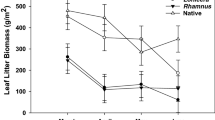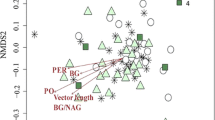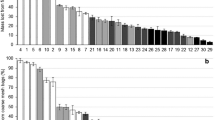Abstract
Invasive terrestrial isopods are likely to have altered leaf litter decomposition processes in North American forests, but the mechanisms underlying these alterations and the degree to which they differ among isopod species are poorly characterized. Using mixed-deciduous leaf litter microcosms, we quantified the effects of two common, invasive isopods (Oniscus asellus and Porcellio scaber) on short-term leaf litter decomposition and microbial community structure and function. Microcosms containing ground litter and a microbial inoculant were exposed to one of the two isopod species or no isopods for 21 days. Mass loss was then quantified as the change in litter dry mass after leaching, and microbial respiration was quantified as the mass of CO2 absorbed by soda lime. Litter leachates were plated on agar to quantify culturable bacterial and fungal abundance, and denaturing gradient gel electrophoresis of amplified leachate microbial DNA was used to characterize shifts in microbial community structure. Isopod presence increased litter mass loss by a modest ~ 6%, but did not affect litter microbial respiration. Bacterial abundance increased significantly in the presence of isopods, while fungal abundance was either unchanged or reduced. Overall litter microbial species richness was reduced by isopods, with O. asellus specifically reducing fungal abundance and diversity. Isopods modified the microbial community structure by suppressing four bacterial and one fungal species, while promoting growth of four other bacterial species (two unique to each isopod species) and two fungal species (one which was unique to O. asellus).








Similar content being viewed by others
References
Palmén E (1958) The role of European species in the Newfoundland fauna of chilopods, diplopods and terrestrial isopods. Proc X Int Congr Entomol 1:899–902
Hornung E, Szlavecz K, Dombos M (2015) Demography of some non-native isopods (Crustacea, Isopoda, Oniscidea) in a Mid-Atlantic forest. USA ZooKeys 127
Szlavecz K, Vilisics F, Tóth Z, Hornung E (2018) Terrestrial isopods in urban environments: an overview. ZooKeys 801:97–126
Szlávecz K, Pobozsny M (1995) Coprophagy in isopods and diplopods: a case for indirect interaction. Acta Zool Fenn 196:124–128
Szlávecz K, Maiorana VC (1998) Supplementary food in the diet of the terrestrial isopod Porcellio scaber Latr. (Isopoda: Oniscidea). Israel J Zool 44:413–422
Ihnen K, Zimmer M (2008) Selective consumption and digestion of litter microbes by Porcellio scaber (Isopoda: Oniscidea). Pedobiologia 51:335–342
Kostanjšek R, Milatovič M, Štrus J (2010) Endogenous origin of endo-β-1, 4-glucanase in common woodlouse Porcellio scaber (Crustacea, Isopoda). J Comp Physiol B 180:1143–1153
Delhoumi M, Zaabar W, Bouslama MF, Achouri MS (2019) Effect of symbiont acquisition on growth, survival and fertility of the terrestrial isopod Porcellionides pruinosus (Crustacea, Oniscidea). Invertebr Reprod Dev 63:60–66
Uesbeck M, Topp W (1995) The effect of leaf litter, microorganisms and Collembola on the food allocation of Oniscus asellus (Isopoda). Crustac Issue:121–132
Bredon M, Herran B, Lheraud B, Bertaux J, Grève P, Moumen B, Bouchon D (2019) Lignocellulose degradation in isopods: new insights into the adaptation to terrestrial life. BMC Genomics 20:462
Sfenthourakis S, Hornung E (2018) Isopod distribution and climate change. ZooKeys 801:25–61
Teuben A, Roelofsma TAPJ (1990) Dynamic interactions between functional groups of soil arthropods and microorganisms during decomposition of coniferous litter in microcosm experiments. Biol Fertil Soils 9:145–151
Bonkowski M (2004) Protozoa and plant growth: the microbial loop in soil revisited. New Phytol 162:617–631
Verhoef H, Brussaard L (1990) Decomposition and nitrogen mineralization in natural and agroecosystems: the contribution of soil animals. Biogeochem. 11:175–211
Grandy AS, Wieder WR, Wickings K, Kyker-Snowman E (2016) Beyond microbes: are fauna the next frontier in soil biogeochemical models? Soil Biol. Biochem. 102:40–44
Bardgett RD, Chan KF (1999) Experimental evidence that soil fauna enhance nutrient mineralization and plant nutrient uptake in montane grassland ecosystems. Soil Biol Biochem 31:1007–1014
Hanlon RDG, Anderson JM (1980) Influence of macroarthropod feeding activities on microflora in decomposing oak leaves. Soil Biol Biochem 12:255–261
Seastedt TR (1984) The role of microarthropods in decomposition and mineralization processes. Annu Rev Entomol 29:25–46
Cragg RG, Bardgett RD (2001) How changes in soil faunal diversity and composition within a trophic group influence decomposition processes. Soil Biol Biochem 33:2073–2081
Huhta V, Haimi J, Setälä H (1991) Role of the fauna in soil processes: techniques using simulated forest floor. Agric Ecosyst Environ 34:223–229
Hättenschwiler S, Gasser P (2005) Soil animals alter plant litter diversity effects on decomposition. Proc Natl Acad Sci 102:1519–1524
Bray N, Kao-Kniffin J, Frey S, Fahey T, Wickings K (2019) Soil macroinvertebrate presence alters microbial community composition and activity in the rhizosphere. Front Microbiol 10:256
Quadros AF, Araujo PB (2008) An assemblage of terrestrial isopods (Crustacea) in southern Brazil and its contribution to leaf litter processing. Rev Bras Zool 25:58–66
Burke JL, Maerz JC, Milanovich JR, Fisk MC, Gandhi KJ (2011) Invasion by exotic earthworms alters biodiversity and communities of litter-and soil-dwelling oribatid mites. Diversity 3:155–175
Sackett TE, Smith SM, Basiliko N (2013) Indirect and direct effects of exotic earthworms on soil nutrient and carbon pools in North American temperate forests. Soil Biol Biochem 57:459–467
Ferlian O, Thakur MP, Castañeda González A, San Emeterio LM, Marr S, da Silva RB, Eisenhauer N (2019) Soil chemistry turned upside down: a meta-analysis of invasive earthworm effects on soil chemical properties. Ecology 101(3):e02936
McCay TS, Scull P (2019) Invasive lumbricid earthworms in northeastern North American forests and consequences for leaf-litter fauna. Biol Invasions 21:2081–2093
Hendrix PF, Bohlen PJ (2002) Exotic earthworm invasions in North America: ecological and policy implications. Biosci. 52:801–811
Alban DH, Berry EC (1994) Effects of earthworm invasion on morphology, carbon, and nitrogen of a forest soil. Appl Soil Ecol 1:243–249
Hassall M, Turner JG, Rands MRW (1987) Effects of terrestrial isopods on the decomposition of woodland leaf litter. Oecologia 72:597–604
Reis F, Nascimento E, Castro H, Canhoto C, Gonçalves AL, Simões S, García-Palacios P, Milla R, Sousa JP, da Silva PM (2018) Land management impacts on the feeding preferences of the woodlouse Porcellio dilatatus (Isopoda: Oniscidea) via changes in plant litter quality. Appl Soil Ecol 132:45–52
Petersen H, Luxton M (1982) A comparative analysis of soil fauna populations and their role in decomposition processes. Oikos 39:288–388
Dilly O, Bartsch S, Rosenbrock P, Buscot F, Munch JC (2001) Shifts in physiological capabilities of the microbiota during the decomposition of leaf litter in a black alder (Alnus glutinosa (Gaertn.) L.) forest. Soil Biol Biochem 33:921–930
Reichle DE (1977) The role of soil invertebrates in nutrient cycling. Ecol Bull 25:145–156
Dunger FH (1983) Tiere im Boden. Die Neue-Brehm Buecherei 327. A. Ziemsen Verlag, Wittenberg-Lutherstadt
Ristok C, Leppert KN, Scherer-Lorenzen M, Niklaus PA, Bruelheide H (2019) Soil macrofauna and leaf functional traits drive the decomposition of secondary metabolites in leaf litter. Soil Biol Biochem 135:429–437
Beare MH, Parmelee RW, Hendrix PF, Cheng W, Coleman DC, Crossley Jr D (1992) Microbial and faunal interactions and effects on litter nitrogen and decomposition in agroecosystems. Ecol Monogr 62:569–591
David J-F (2014) The role of litter-feeding macroarthropods in decomposition processes: a reappraisal of common views. Soil Biol Biochem 76:109–118
Hanlon RDG, Anderson JM (1979) The effects of collembola grazing on microbial activity in decomposing leaf litter. Oecologia 38:93–99
Hättenschwiler S, Tiunov AV, Scheu S (2005) Biodiversity and litter decomposition in terrestrial ecosystems. Annu Rev Ecol Evol Syst 36:191–218
Ulyshen MD, Wagner TL (2013) Quantifying arthropod contributions to wood decay. Methods Ecol Evol 4:345–352
De Menezes AB, Prendergast-Miller MT, Macdonald LM, Toscas P, Baker G, Farrell M, Wark T, Richardson AE, Thrall PH (2018) Earthworm-induced shifts in microbial diversity in soils with rare versus established invasive earthworm populations. FEMS Microbiol Ecol 94:fiy051
Moore JC, Walter DE, Hunt HW (1988) Arthropod regulation of micro- and mesobiota in below-ground detrital food webs. Annu Rev Entomol 33:419–435
Kayang H, Sharma G, Mishra R (1996) The influence of isopod grazing on microbial dynamics in decomposing leaf litter of Alnus nepalensis D. Don. Eur J Soil Biol 32:35–40
Majed D, Wahiba Z, Fadhel BM, Sghaier AM (2018) Characterization of the dominant bacterial communities associated with terrestrial isopod species based on 16S rDNA analysis by PCR-DGGE. Open J Ecol 8:495–509
Ullrich B, Storch V, Schairer H (1991) Bacteria on the food, in the intestine and on the faeces of the woodlouse Oniscus asellus (Crustacea, Isopoda). Species composition and nutritive value. Pedobiologia 35:41–51
Zimmer M, Topp W (1999) Relationships between woodlice (Isopoda: Oniscidea) and microbial density and activity in the field. Biol Fertil Soils 30:117–123
Zimmer M, Topp W (2002) The role of coprophagy in nutrient release from feces of phytophagous insects. Soil Biol Biochem 34:1093–1099
Lavelle P, Decaëns T, Aubert M, Sb B, Blouin M, Bureau F, Margerie P, Mora P, Rossi J-P (2006) Soil invertebrates and ecosystem services. Eur J Soil Biol 42:S3–S15
Zimmer M (2002) Nutrition in terrestrial isopods (Isopoda: Oniscidea): an evolutionary-ecological approach. Biol Rev Camb Phil Soc 77:455–493
Gunnarsson T, Tunlid A (1986) Recycling of fecal pellets in isopods: microorganisms and nitrogen compounds as potential food for Oniscus asellus L. Soil Biol Biochem 18:595–600
Blagodatskaya EV, Anderson T-H (1998) Interactive effects of pH and substrate quality on the fungal-to-bacterial ratio and QCO2 of microbial communities in forest soils. Soil Biol Biochem 30:1269–1274
Leff JW, Nemergut DR, Grandy AS, O’Neill SP, Wickings K, Townsend AR, Cleveland CC (2012) The effects of soil bacterial community structure on decomposition in a tropical rain forest. Ecosystems 15:284–298
Hedlund K, Augustsson A (1995) Effects of enchytraeid grazing on fungal growth and respiration. Soil Biol Biochem 27:905–909
Holtkamp R, Kardol P, van der Wal A, Dekker SC, van der Putten WH, de Ruiter PC (2008) Soil food web structure during ecosystem development after land abandonment. Appl Soil Ecol 39:23–34
Zimmer M, Kautz G, Topp W (2003) Leaf litter-colonizing microbiota: supplementary food source or indicator of food quality for Porcellio scaber (Isopoda: Oniscidea)? Eur J Soil Biol 39:209–216
Dudgeon D, Ma H, Lam P (1990) Differential palatability of leaf litter to four sympatric isopods in a Hong Kong forest. Oecologia 84:398–403
Quadros AF, Caubet Y, Araujo PB (2009) Life history comparison of two terrestrial isopods in relation to habitat specialization. Acta Oecol 35:243–249
Wood CT, Araujo PB, Štrus J (2017) Morphology, microhabitat selection and life-history traits of two sympatric woodlice (Crustacea: Isopoda: Oniscidea): a comparative analysis. Zool Anz 268:1–10
Wijnhoven H (2000) Landpissebedden van de Ooijpolder: deel 1. verspreiding (Crustacea: Isopoda: Oniscidea). Ned Faunistische Meded 11:55–131
Warburg M, Linsenmair K, Bercovitz K (1984) The effect of climate on the distribution and abundance of isopods. Symposia of the Zoological Society of London, pp 339–367
Brereton JLG (1957) The distribution of woodland isopods. Oikos 8:85–106
Warburg MR (1968) Behavioral adaptations of terrestrial isopods. Integr Comp Biol 8:545–559
Gerlach A, Russell D, Jaeschke B, Römbke J (2014) Feeding preferences of native terrestrial isopod species (Oniscoidea, Isopoda) for native and introduced leaf litter. Appl Soil Ecol 83:95–100
Crowther TW, Boddy L, Jones TH (2011) Species-specific effects of soil fauna on fungal foraging and decomposition. Oecologia 167:535–545
Hopkin SP (1990) Species-specific differences in the net assimilation of zinc, cadmium, lead, copper and iron by the terrestrial isopods Oniscus asellus and Porcellio scaber. J Appl Ecol 27:460–474
Gunnarsson T (1987) Selective feeding on a maple leaf by Oniscus asellus (Isopoda). Pedobiologia 30:161–165
Hättenschwiler S, Bretscher D (2001) Isopod effects on decomposition of litter produced under elevated CO2, N deposition and different soil types. Glob Chang Biol 7:565–579
Wieser W, Schweizer G, Hartenstein R (1969) Patterns in the release of gaseous ammonia by terrestrial isopods. Oecologia 3:390–400
Braun EL (1950) Deciduous forests of Eastern North America. London Publishing Co., New York
Trofymow JA, Preston CM, Prescott CE (1995) Litter quality and its potential effect on decay rates of materials from Canadian forests. Water Air Soil Pollut 82:215–226
Otis KV (2012) Leaf litter decomposition in vernal pools of a Central Ontario mixedwood forest. Dissertation, University of Guelph.
Killingbeck KT (1996) Nutrients in senesced leaves: keys to the search for potential resorption and resorption proficiency. Ecology 77:1716–1727
Brockett BF, Hassall M (2005) The existence of an Allee effect in populations of Porcellio scaber (Isopoda: Oniscidea). Eur J Soil Biol 41:123–127
Balkwill DL, Leach FR, Wilson JT, McNabb JF, White DC (1988) Equivalence of microbial biomass measures based on membrane lipid and cell wall components, adenosine triphosphate, and direct counts in subsurface aquifer sediments. Microb Ecol 16:73–84
Edwards NT (1982) The use of soda-lime for measuring respiration rates in terrestrial systems. Pedobiologia 23:321–330
Gordon AM, Schlenter RE, van Cleve K (1987) Seasonal patterns of soil respiration and CO2 evolution following harvesting in the white spruce forests of interior Alaska. Can J For Res 17:304–310
Jarvis B (1973) Comparison of an improved rose bengal-chlortetracycline agar with other media for the selective isolation and enumeration of moulds and yeasts in foods. J Appl Microbiol 36:723–727
Barron GL (1968) The genera of hyphomycetes from soil. Waverly Press Inc., Baltimore
Domsch KH, Gams W, Anderson TH (1995) Compendium of soil fungi. Lubrecht & Cramer Ltd., New York, pp 1,264
Watanabe T (2002) Pictorial atlas of soil and seed fungi: morphologies of cultured fungi and key to species. CRC Press, New York
Das M, Royer TV, Leff LG (2007) Diversity of fungi, bacteria, and actinomycetes on leaves cecomposing in a stream. Appl Environ Microbiol 73:756–767
Dilly O, Bloem J, Vos A, Munch JC (2004) Bacterial diversity in agricultural soils during litter decomposition. Appl Environ Microbiol 70:468–474
Schindelin J, Arganda-Carreras I, Frise E, Kaynig V, Longair M, Pietzsch T, Preibisch S, Rueden C, Saalfeld S, Schmid B, Tinevez J-Y, White DJ, Hartenstein V, Eliceiri K, Tomancak P, Cardona A (2012) Fiji: an open-source platform for biological-image analysis. Nat Methods 9:676–682
Taylor SC, Berkelman T, Yadav G, Hammond M (2013) A defined methodology for reliable quantification of Western blot data. Mol Biotechnol 55:217–226
Oksanen J, Blanchet FG, Friendly M, Kindt R, Legendre P, McGlinn D, Minchin PR, O'Hara RB, Simpson GL, Solymos P, Stevens MHH, Szoecs E, Wagner H (2018) Vegan: community ecology package. R package version 2.4-6. (https://CRAN.R-project.org/package = vegan)
Zimmer M, Danko J, Pennings S, Danford A, Carefoot T, Ziegler A, Uglow R (2002) Cellulose digestion and phenol oxidation in coastal isopods (Crustacea: Isopoda). Mar Biol 140:1207–1213
Smith A, Zoetendal E, Mackie R (2005) Bacterial mechanisms to overcome inhibitory effects of dietary tannins. Microb Ecol 50:197–205
Zimmer M (1999) The fate and effects of ingested hydrolyzable tannins in Porcellio scaber. J Chem Ecol 25:611–628
Zimmer M, Topp W (1997) Does leaf litter quality influence population parameters of the common woodlouse, Porcellio scaber (Crustacea: Isopoda)? Biol Fertil Soils 24:435–441
Neuhauser E, Hartenstein R (1976) Degradation of phenol, cinnamic acid and quinic acid in the terrestrial crustacean, Oniscus asellus. Soil Biol Biochem 8:95–98
Magan N, Lynch JM (1986) Water potential, growth and cellulolysis of fungi involved in decomposition of cereal residues. J Gen Microbiol 132:1181–1187
Broder MW, Wagner GH (1988) Microbial colonization and decomposition of corn, wheat, and soybean residue. Soil Sci Soc Am J 52:112–117
Kuter GA (1986) Microfungal populations associated with the decomposition of sugar maple leaf litter. Mycologia 78:114–126
Hering TF (1965) Succession of fungi in the litter of a lake district Oakwood. Trans Br Mycol Soc 48:391–408
Dittmer J, Lesobre J, Moumen B, Bouchon D (2016) Host origin and tissue microhabitat shaping the microbiota of the terrestrial isopod Armadillidium vulgare. FEMS Microbiol Ecol 92(5):fiw063
Liang B, Lehmann J, Sohi SP, Thies JE, O’Neill B, Trujillo L, Gaunt J, Solomon D, Grossman J, Neves EG (2010) Black carbon affects the cycling of non-black carbon in soil. Org Geochem 41:206–213
Hoorens B, Aerts R, Stroetenga M (2002) Litter quality and interactive effects in litter mixtures: more negative interactions under elevated CO2? J Ecol 90:1009–1016
Fanin N, Hättenschwiler S, Barantal S, Schimann H, Fromin N (2011) Does variability in litter quality determine soil microbial respiration in an Amazonian rainforest? Soil Biol Biochem 43:1014–1022
Larkin R, Kelly J (1988) A short-term microcosm evaluation of CO2 evolution from litter and soil as influenced by SO2 and SO4 additions. Water Air Soil Pollut 37:273–280
McGonigle TP (2007) Effects of animals grazing on fungi. In: Kubicek CP, Druzhinina IS (eds) The mycota IV environmental and microbial relationships. Springer-Verlag, Berlin
Szlavecz K (1995) Diversity and spatial community structure of terrestrial isopods (Isopoda, Oniscidea) in a mosaic of plant assemblages. Crustac Issue 7:97–106
McGlynn TP, Poirson EK (2012) Ants accelerate litter decomposition in a Costa Rican lowland tropical rain forest. J Trop Ecol 28:437–443
Hyde KD, Xu J, Rapior S, Jeewon R, Lumyong S, Niego AGT, Abeywickrama PD, Aluthmuhandiram JV, Brahamanage RS, Brooks S (2019) The amazing potential of fungi: 50 ways we can exploit fungi industrially. Fungal Divers 97:1–136
Sousa JP, Loureiro S, Pieper S, Frost M, Kratz W, Nogueira AJ, Soares AM (2000) Soil and plant diet exposure routes and toxicokinetics of lindane in a terrestrial isopod. Environ Toxicol Chem 19:2557–2563
Achouri MS, Medini-Bouaziz L, Hamaied S, Charfi-Cheikhrouha F (2008) Diversity of terrestrial isopods at the Oued Laou region (Northeast of Morocco): preliminary results. Du bassin versant vers la mer: Analyse multidisciplinaire pour une gestion durable Travaux de l’Institut Scientifique, Rabat, Série générale 5: 75-79.
Acknowledgments
We would like to thank Shawn Lyons for assistance with experimental preparation and data collection, Kamini Khosla for assistance with DGGE, Moria Robinson for assistance with DGGE analysis, and Sarah Smith for fungal identification.
Funding
This research was supported by the University of Guelph.
Author information
Authors and Affiliations
Corresponding author
Ethics declarations
Conflict of Interest
The authors declare that they have no conflict of interest.
Electronic supplementary material
ESM 1
(DOCX 14 kb)
Rights and permissions
About this article
Cite this article
Des Marteaux, L.E., Kullik, S.A., Habash, M. et al. Terrestrial Isopods Porcellio scaber and Oniscus asellus (Crustacea: Isopoda) Increase Bacterial Abundance and Modify Microbial Community Structure in Leaf Litter Microcosms: a Short-Term Decomposition Study. Microb Ecol 80, 690–702 (2020). https://doi.org/10.1007/s00248-020-01527-4
Received:
Accepted:
Published:
Issue Date:
DOI: https://doi.org/10.1007/s00248-020-01527-4




